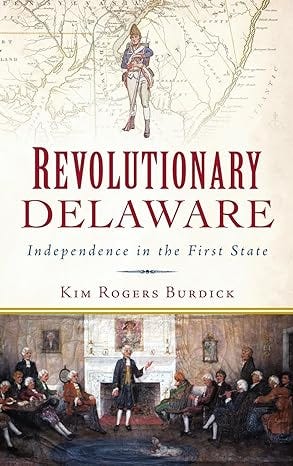Book review: Revolutionary Delaware: Independence in the First State by Kim Rogers Burdick
The fight for freedom in the First State was surprising.
Recently my wife and I spent a weekend staying canalside in Lewes, and on a sunny Saturday we went exploring downtown. My souvenir was this book, which was an enjoyable read for a person who likes local history.
In the annals of the Revolutionary War, only one battle was fought in what had just become known as Delaware - prior to 1776, it was considered the Three Lower Counties of Pennsylvania. The Battle of Cooch’s Bridge in September, 1777 was a defeat for the overwhelmed and outnumbered Americans as the British and Hessian forces were moving eastward from the mouth of Chesapeake Bay toward Philadelphia. (This led up to the Battle of Brandywine, which occurred just across the border in Pennsylvania.)
While the northern portion of Delaware was (as it is now) considered a major highway along the East Coast - meaning thousands of troops and tons of supplies worked their way through the northern tip of the state then (as now) based in Wilmington, author Kim Rogers Burdick not only detailed this aspect of the conflict but focused as well on two other points of our struggle for independence.
Keeping the shipping lanes secure was of paramount importance. Defending Delaware meant preventing the British from sailing up Delaware Bay to Philadelphia, and while there were skirmishes from time to time, the defense system employed by the colonists and their naval fleet was effective enough that the British Navy instead sailed up Chesapeake Bay to begin its offensive that included the battles of Cooch’s Bridge and Brandywine. As a port city, this made Lewes and nearby Cape Henlopen a key outpost in the war.
But the most fascinating part of the book to me was Burdick’s detailing of the mixed loyalties in the state. There were still many thousands in Delaware who were loyal to King George III, and at times they were a hindrance to the effort. At times it was neighbor vs. neighbor in an uneasy truce, with the backdrop of a shooting war just a couple days’ ride away. Tory sentiments seemed to be more prevalent in the southern part of Delaware.
The other aspect was the effect on the pacifist Quakers in the state, which was a natural outgrowth of its roots as a part of Pennsylvania. While some Quakers indeed took up arms and joined in the battle for independence, the stubborn neutrality of others led many to believe they were British loyalists as well. In 1777, at the same time fighting was underway at Cooch’s Bridge, the Continental Congress “recommended that records of Quaker meetings be seized.”
Later in the conflict as fighting shifted to the south, many Delaware men fought bravely in the Carolinas, helping to finally evict the British in 1781.
Without the thirty or so pages of Notes and the Index, Revolutionary Delaware checks in at a breezy 144 pages, so it’s not a long book as befits a relatively small state. One thing I noticed in the bookstore was a similar-looking companion book (by a different author) on Delaware in the Civil War. I almost bought them both, but decided one would suffice for now. Given the quality and scholarship of this volume, I doubt I will be disappointed.
We all had to start from somewhere, and if you’re a Delaware native this book did you proud.
Until next time, also remember you can Buy Me a Coffee since I have a page there.





It is important we know our real history. Not the twisted version we are getting and the one our children are being taught. Thank you Michael.
Wow what a great read! As you know, I am a Revolutionary War aficionado.